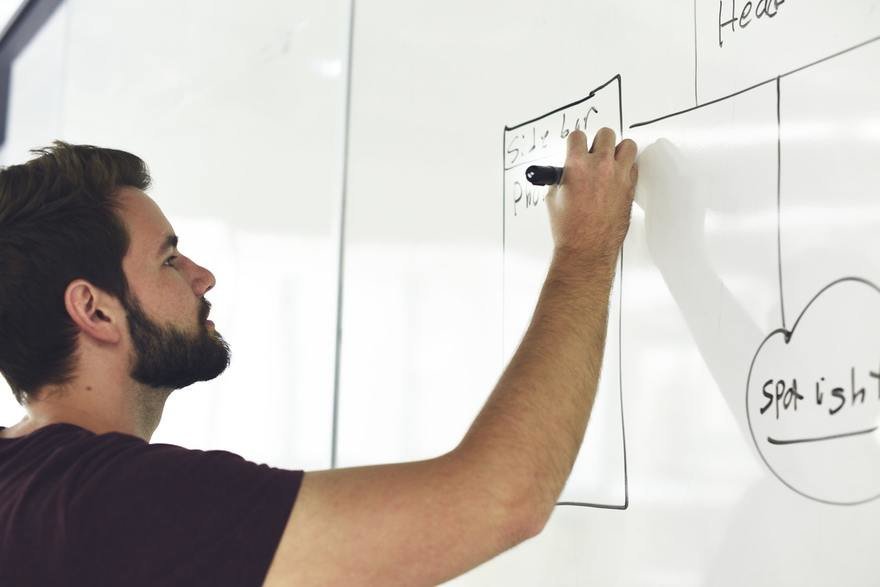#HTE
5 Ways to Get More Out of Your Brainstorming Session
Ah, the brainstorming session. It’s the cornerstone of team interactions and project-based workflows everywhere. Traditional brainstorming sessions—the ones where everyone sits around a conference table and takes turns throwing out ideas—can be effective, but there are definitely better ways to go about it. If your brainstorming sessions operate the same way they did 10 years ago—or even 2 years ago—it may be time for an update.

Are your brainstorming sessions losing their luster? Are you ready to supercharge your team’s creative powers to help them come up with new, better, and more innovative solutions?
Then it’s time for you to check out these strategies for getting more your of your next brainstorming session:
- Online brainstorming
-Brain writing
- Figuring storming
- Starbursting
- Sticky note ideation

1. Online brainstorming
The increasing prevalence of virtual teams has in turn made online brainstorming and increasingly common practice, but this technique is valuable for anyone who is organizing a team project. The key to online brainstorming is creating a central location where everyone can collaborate on a single brainstorming document.
Not only does this allow you to include team members who may not be in the conference room with you—it also gives your team the ability to review or add to conversations started in person later on. Since people reach their peak creativity at different points in their day, creating an collaborative online document to house all of your team’s thoughts and ideas ensures that everybody has the chance to put their best and brightest ideas into the ring.
How to do it: Host a brief kickoff meeting where you go over the problem, do some light brainstorming, and share the online brainstorming document with your team. Give your team a few days to add to the document before reconvening for more thorough brainstorming.

2. Brain Writing
If you’ve ever dappled in creative writing, you might be familiar with the process of freewriting—when a writer sits down and writes out everything that comes to mind without editing or interfering with the flow of ideas at all. This same basic principle can be applied to other projects as well.
The benefit of brain writing is that it separates the process of ideation—or idea generation—from discussion, allowing your team to fully develop their ideas before sharing them.
How to do it: At the beginning of your brainstorming session, have your team spend a few minutes writing down all of their thoughts about the issue. These can range from analyzing stakeholders or identifying personas to really digging into a particular idea they have about where the project should go.

3. Figure Storming
Sometimes cracking a difficult problem is all a matter of perspective. If your team is getting stuck on a certain problem or aspect of a project, it might be time for them to step back and look at the situation from another person’s point of view.
Now, we’re not talking about stakeholders or users here—incorporating those perspectives is a part of the design process to begin with. Figure storming is a creative exercise that involves choosing a completely unrelated figure, and using their point of view to help your team think about the project or problem in new ways.
How to do it: Select a well-known figure with (and this part is key) an extremely clear set of values or ideas. For example, you might select Abe Lincoln, your favorite pop star, a superhero, or any other figure your team feels comfortable working with. Then simply begin with the question “What would Abe/the pop star/the superhero/etc. do?” and watch the ideas start flowing.

4. Starbursting
While this strategy sounds pretty sweet, it unfortunately has nothing to do with the candy (although if you really wanted it to, you could certainly reinvigorate your team with some sugary snacks).
Many brainstorming sessions start out with a team discussing what they already know about the problem or project at hand. Starbursting flips this strategy on its head by replacing statements with questions. It’s more or less an extension of the Socratic teaching method—which means Starbursting is all about asking questions in order to really prove what you know about a topic.
How to do it: Instead of asking your team what they know about the situation, ask them to focus on what they don’t know. Have your team formulate questions about the project, and make sure to write all of them down. You may have the answers to some of the questions already, but spending some time thinking about what information isn’t the most obvious can help you reveal important revelations about the project.

5. Sticky Note Ideation
Sticky note ideation sounds somewhat whimsical, but it’s actually an extremely powerful brainstorming tool that is used to promote rapid ideation and help eliminate creative roadblocks like groupthink.
During a sticky note ideation session, your team will write each of their ideas out on sticky notes—one idea per note. Sticky notes can include everything from questions and thoughts to suggestions and solutions. After ideating independently, the group comes together and shares their sticky notes, which should facilitate discussion.
How to do it: Give each team member a Sharpie and a pad of sticky notes. Give them 5 minutes to work independently, and tell them to get as many thoughts down on sticky notes as possible. At the end of the 5 minutes, go around and have each person explain their thoughts as they place their sticky notes in the center of the table or on a wall. Stack any duplicate sticky notes that come up as you go around the room. Discuss different ways of organizing the sticky notes and—more importantly—actually manipulate the sticky notes as you think about combining ideas.

Brainstorming has always been a key part of getting any project off the ground, but that doesn’t mean the brainstorming process has to be old and tired. Get more out of your next brainstorming session by testing out these tips, tricks, and tools for jumpstarting your team’s creativity.
This is a sponsored post for Dropbox. All opinions are my own. Dropbox is not affiliated with nor endorses any other products or services mentioned.
https://www.core77.com/posts/80712/5-Ways-to-Get-More-Out-of-Your-Brainstorming-Session
